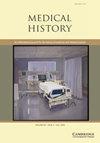瘟疫与蒙古征服巴格达(1258 年)?重新评估资料来源
IF 1.1
2区 哲学
Q4 HEALTH CARE SCIENCES & SERVICES
引用次数: 0
摘要
本文重新审查了 N. Fancy 和 M.H. Green 在 "鼠疫与巴格达的陷落(1258 年)"(《医学史》,65/2 (2021),157-177)一文中使用的资料来源。(医学史》,65/2 (2021),157-177)中使用的资料。Fancy 和 Green 认为,阿拉伯语和波斯语对蒙古人围攻伊朗和伊拉克,特别是 1258 年攻陷巴格达的描述表明,蒙古人解除围攻后,被围困的要塞和城市受到了鼠疫的侵袭。他们认为,这是蒙古在欧亚大陆扩张过程中一再爆发瘟疫的模式之一。Fancy 和 Green 得出结论认为,原始资料证实了近期古遗传学研究提出的理论,即 13 世纪蒙古人的征服为 14 世纪中叶的大规模瘟疫奠定了基础。瘟疫爆发与蒙古人围攻巴格达之间的联系依赖于三段几乎同时发生的历史记载。然而,我们对资料来源的重新研究表明,主要文本(波斯文)被严重误解,另外两个文本(叙利亚文和阿拉伯文)被错误地理解,因此没有得到正确理解。这些文本并不支持作者关于 1258 年巴格达瘟疫流行的说法,也不支持作者从叙利亚和埃及引用的其他当代和后来的阿拉伯语文本,我们在此对这些文本重新进行了详细研究。我们的结论是,没有证据表明在蒙古征服中东期间或之后出现过鼠疫,当然也没有证据表明鼠疫是由蒙古人传播的。本文章由计算机程序翻译,如有差异,请以英文原文为准。
Plague and the Mongol conquest of Baghdad (1258)? A reevaluation of the sources
This paper reexamines the sources used by N. Fancy and M.H. Green in “Plague and the Fall of Baghdad (1258)” (Medical History, 65/2 (2021), 157–177). Fancy and Green argued that the Arabic and Persian descriptions of the Mongol sieges in Iran and Iraq, and in particular, in the conquest of Baghdad in 1258, indicate that the besieged fortresses and cities were struck by Plague after the Mongol sieges were lifted. This, they suggested, is part of a recurrent pattern of the outbreak of Plague transmitted by the Mongol expansion across Eurasia. Fancy and Green concluded that the primary sources substantiate the theory driven by recent paleogenetic studies indicating that the Mongol conquests of the thirteenth century set the stage for the massive pandemic of the mid-fourteenth century. The link between the Plague outbreak and the Mongol siege of Baghdad relies on three near-contemporaneous historical accounts. However, our re-examination of the sources shows that the main text (in Persian) has been significantly misunderstood, and that the two other texts (in Syriac and Arabic) have been mis-contextualized, and thus not understood properly. They do not support the authors’ claim regarding Plague epidemic in Baghdad in 1258, nor do other contemporary and later Arabic texts from Syria and Egypt adduced by them, which we re-examine in detail here. We conclude that there is no evidence for the appearance of Plague during or immediately after the Mongol conquests in the Middle East, certainly not for its transmission by the Mongols.
求助全文
通过发布文献求助,成功后即可免费获取论文全文。
去求助
来源期刊

Medical History
医学-科学史与科学哲学
CiteScore
1.60
自引率
0.00%
发文量
25
审稿时长
>12 weeks
期刊介绍:
Medical History is a refereed journal devoted to all aspects of the history of medicine and health, with the goal of broadening and deepening the understanding of the field, in the widest sense, by historical studies of the highest quality. It is also the journal of the European Association for the History of Medicine and Health. The membership of the Editorial Board, which includes senior members of the EAHMH, reflects the commitment to the finest international standards in refereeing of submitted papers and the reviewing of books. The journal publishes in English, but welcomes submissions from scholars for whom English is not a first language; language and copy-editing assistance will be provided wherever possible.
 求助内容:
求助内容: 应助结果提醒方式:
应助结果提醒方式:


